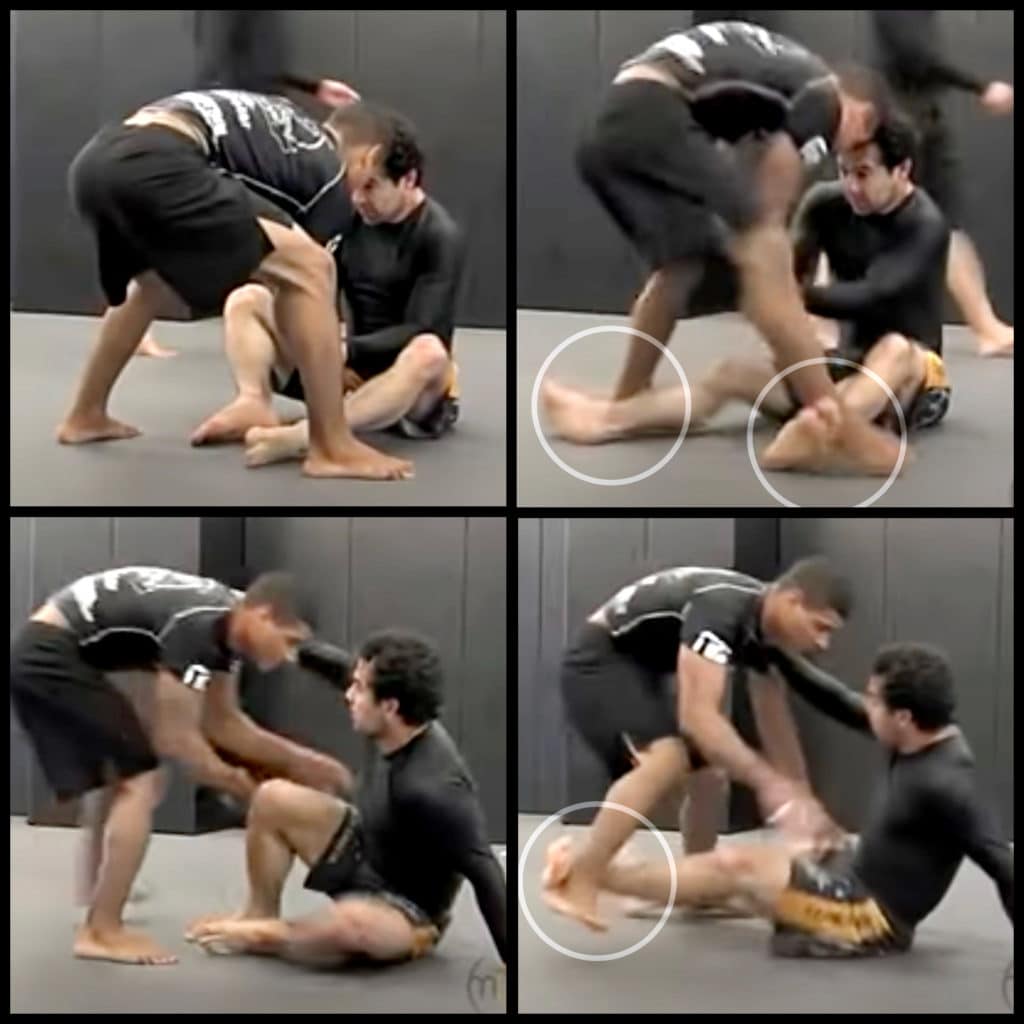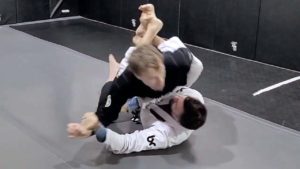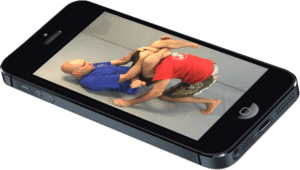If you don’t have a gameplan from the open guard then this position can quickly become a confusing and ineffective tangle of arms and legs .
And open guard chaos gets much, much worse when you don’t have a good grip on your opponent.
Even a single solid grip on your opponent’s arm, neck, foot, heel or gi allows you to control his posture, limit his movement, and set up your own attacks. Contact with your opponent also makes it a lot easier to feel his movement and anticipate what he’s going to do.
Without a grip or point of contact you’re basically giving your opponent free reign to move around you however he wants and set up his guard passes.
So, open guard… No grips… Could things get harder for you?
Yes. Like if he’s also standing up.
Standing up benefits your opponent in several ways. First of all on his feet he’s less vulnerable to your chokes and armlocks.
Also, since in this scenario you don’t have any grips controlling his movement, your opponent can use his increased standing mobility to pass your guard using lots of using speed and momentum.
Or, even more frustratingly, a standing opponent can refuse refuse to engage and continuously run away from you. This is essentially the conundrum that Roberto “Cyborg” Abreu found himself in when UFC fighter Brendan Schaub essentially refused to engage him on the ground at Metamoris 2. Schaub did a real disservice to the sport with his running man strategy.
Some Solutions…
OK, hopefully we agree that your opponent standing in your open guard can be a major problem. Let’s start talking about solutions specifically when:
- Your opponent is in your open guard, and
- Your opponent is standing up and refusing to engage, and
- You don’t have any grips
The art of jiu-jitsu offers you tons of techniques and strategies to fit every situation. Here are three solutions along with some actual techniques to put those strategies into action.
Option 1: Establish and maintain a connection with your opponent
One way to get control of the situation is fighting to establish some sort of grip or control over your opponent.
Sometimes this is as easy as reaching out and grabbing his wrist, his ankle or his gi.
If you’re doing the open guard from your back (as opposed to the sitting up butterfly guard style of open guard) then sometimes the easiest of these options is to grab his ankle. Even though you’ve only connected to his foot you’ve now limited his ability to step, walk or run; which is a great development in itself.
But it gets even better because there are many open guard attacks and submissions you can launch from just a single grip on his ankle.
When it comes to attacks from this position I suggest you start with the Tripod Sweep and the Tomahawk Sweep, which function as the jab and cross of the open guard position.
You probably learned these two techniques as a white belt, but don’t let that fool you: they are powerful, technically sound techniques that I continue to use against quality opponents at the black belt level.
In fact I once used the Tomahawk sweep even though one of my arms was immobilised in a cast: I was sparring with one arm and tomahawked an aspiring MMA fighter off his feet and into the lap of Marcus Soares, my BJJ coach, who was sitting at the side of the mat. So I know that this sweep works!
The Tripod Sweep
The Tomahawk Sweep
The two techniques above rely on controlling your opponent’s ankle with your hands. And it’s wonderful when you can do that.
But you can’t always get your hand to his leg right away…
Sometimes your legs will make contact before your hand. You’ll reach out with your legs and hold him in place for a split-second, just long enough to bring your upper body into play. This approach makes sense because your legs are longer, stronger, and closer to his body than your arms when you’re on your back.
Making contact with your legs first is a high-level strategy that Brendan ‘Wolverine’ Mullins breaks down for you in the video below. This technique is shown from a no gi perspective, but these concepts and techniques work equally well with or without the gi.
How to Fight an Opponent Standing in Your Open Guard
Wasn’t that a cool technique?
Learning the strategy in the video above was one of the many highlights of my time with Brandon as we were filming the How to Defeat the Bigger Stronger Opponent videos down in Texas.
And just in case you’re wondering about the sweep that Brandon used, it’s basically a variation of the ‘standup sweep’ which is broken down for you below…
The Standup Sweep from X Guard
Option 2: Become mobile and continuously threaten your own attacks
Option 2 is similar, but now the goal is to sweep your opponent as soon as you make your connection, rather than making your connection first and then working for the sweep afterwards.
In this more aggressive way of doing things you’ll actively push the pace and actually chase your opponent, with the goal of being in the right position to sweep your opponent the instant you make contact. It can be very disconcerting to be standing up and have your opponent be aggressively and relentlessly chasing you from his butt; it’s definitely a man-bites-dog moment!
To do this you can actually use many of the same attacks we talked about in the first part of this article. But to keep this interesting let’s look at a different sweep from a different style of open guard, namely the Seated Guard or the the Butterfly Guard.
Here’s a really good breakdown of the Seated Guard by Emily Kwok. And there are THREE things I especially want you to take away from this
- The way Emily continuously works to get the correct range, using her mobility to thwart my guard pass attempts (mostly in the first half of the video),
- The integration of the Technical Standup at 6:05 in the video (more about that below)
- The ‘Knee Push’ sweep at 6:34 (again, more about that below)
Let’s talk a bit about the Knee Push Sweep sweep in the second half of the video above…
I called this same move the ‘Idiot Sweep’ in my Guard Sweeps App because you feel like a moron when you get caught in something this simple. But it really works well, especially when you follow it up by getting on top of your opponent right away.
If your opponent is standing above you then you should continuously be hooking his ankles with your insteps and threatening the Knee Push sweep.
It’s kind of like the jab in boxing; don’t know what else to do? Try the Knee Push sweep again! At the very least it’ll keep your opponent off balance and responding to you, rather than giving him the time and mental space to set up his own attacks.

Marcelo Garcia Attacking with the Knee Push / Idiot Sweep
Click here for an awesome illustration of the Knee Push Sweep in action where Marcelo Garcia is sparring with the highly skilled JT Torres.
JT is definitely NOT stalling, but Marcelo is still continuously hooking the ankles for the first 20 seconds just like a boxer pumping out that jab again and again. Then he hits the sweep itself, JT begins to scramble free, but Marcelo instantly follows him and converts the sweep into a single leg takedown. Amazing!
Option 3: Get Up, Stand Up!
Sometimes the solution to a problem is so glaringly in-your-face obvious that you just don’t see it…
And it’s truly amazing how many people get tunnel-visioned when they’re fighting from the open guard and forget all about the possibility of standing back up to their feet.
I have fallen victim to this mentality myself. Back as a white belt with a year or two of training under my belt I was in love with being on the ground and using the guard. But I kept on running into people who stood up, broke my closed guard open, and then passed by running around my legs.
I went to my BJJ coach Marcus Soares for advice, explained what was going on, and he looked at me like I was an idiot. “Stand up and then try to take him down!” he said.
This was super-surprising to me because up to that point I had assumed that BJJ practitioners would never willingly leave the ground once they got there. But here was a high-ranking black belt telling me to get off my butt and get back to my feet. It was a real perspective-shifting moment if ever I’ve had one.
So if you feel like the match is getting away from you, if you just can’t get into an advantageous open guard position on the bottom, then STAND UP.
Get back onto your feet, and then try to take your opponent down and get on top. Or failing that, get back onto your feet, and secure some kind of standing grip on your opponent, and then pull guard again: hopefully you’ll end up in a better position that you can then work from.
A few years ago I wrote an article for Black Belt Magazine called ‘Get Up, Stand Up’ which broke down some different options for getting back to your feet from various guard positions. There was a strong self defence and MMA emphasis to that article, but most of those techniques can be adapted to a BJJ and submission grappling context easily enough.
Also note that there is a proper and correct way to get back your feet: it’s called the Technical Standup.
In the video below I break the Technical Standup down in a streetfighting context, but it’s exactly the same movement when you do it in BJJ class. The Technical Standup is even the core movement for many powerful sweeps from butterfly guard, half guard and X guard, so it’s well worth drilling this movement until it becomes 100% instinctive!
The Technical Standup
To wrap up this article, we covered three main strategies for dealing with an opponent who’s standing above you in the open guard. These options are:
- Establishing some form of control, and/or
- Pursuing and attacking him directly, and/or
- Standing back up to your feet.
Are these options mutually exclusive and clad in stone? Of course not! These 3 solutions often blend and blur into each other; you might start by trying to stand up and then converting to a sweep after your opponent reacts to you. Or the other way around.
Just keep pushing the action, stay flexible, and adapt to changing circumstance: you’ll soon figure out how to take advantage of an otherwise very frustrating situation. And that’s the essence of jiu-jitsu, isn’t it?
More Resources
WHY YOUR GUARD ATTACKS ARE FAILING
Regardless of whether you’re using the open, closed or half guard…
Regardless of whether your opponent is standing, kneeling or crouching…
And regardless of whether you’re going for a sweep, submission or standup…
One of the most important things you can do is to set up your attack using KUZUSHI.
‘Kuzushi’ is the art of breaking your opponent’s alignment and getting him off-balance before you attack.
Without kuzushi you’re simply never going to be able to pull off your moves on anyone good. Fortunately this is a teachable skill with specific movements you can do, ways to link directly from your kuzushi movement into your attack.
Click here to learn more about Kuzushi, and/or click here to check out The Gripfighting and Kuzushi Formula that I did with Rob Biernacki.
THE GRAPPLEARTS BJJ MASTER APP (FREE TO DOWNLOAD)
Many of the videos in this article come from instructionals in the Grapplearts BJJ Master App. This app has a TON of free content, and is insanely convenient to carry around with you.
To paraphrase Steve Jobs, “It’s the simplest way to carry 1,000 techniques in your pocket.”
Check it out for free at the links below:

The post 3 Open Guard Options vs. Standing Opponents appeared first on Grapplearts.



